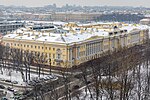Bronze Horseman

The Bronze Horseman (Russian: Медный всадник, literally "copper horseman") is an equestrian statue of Peter the Great in the Senate Square in Saint Petersburg, Russia. It was opened to the public on 7 (18) August 1782. Commissioned by Catherine the Great, it was created by the French sculptor Étienne Maurice Falconet. The name influenced a 1833 poem of the same name by Alexander Pushkin, which is widely considered one of the most significant works of Russian literature. The statue is now one of the symbols of Saint Petersburg. The statue's pedestal is the Thunder Stone, the largest stone ever moved by humans. The stone originally weighed about 1500 tonnes, but was carved down during transportation to its current size and weight of 1,250 tons.
Excerpt from the Wikipedia article Bronze Horseman (License: CC BY-SA 3.0, Authors, Images).Bronze Horseman
Admiralteyskaya Embankment, Saint Petersburg
Geographical coordinates (GPS) Address External links Nearby Places Show on map
Geographical coordinates (GPS)
| Latitude | Longitude |
|---|---|
| N 59.9364 ° | E 30.3022 ° |
Address
Петру Великому (Медный всадник)
Admiralteyskaya Embankment
191011 Saint Petersburg (Адмиралтейский округ)
Saint Petersburg, Russia
Open on Google Maps










